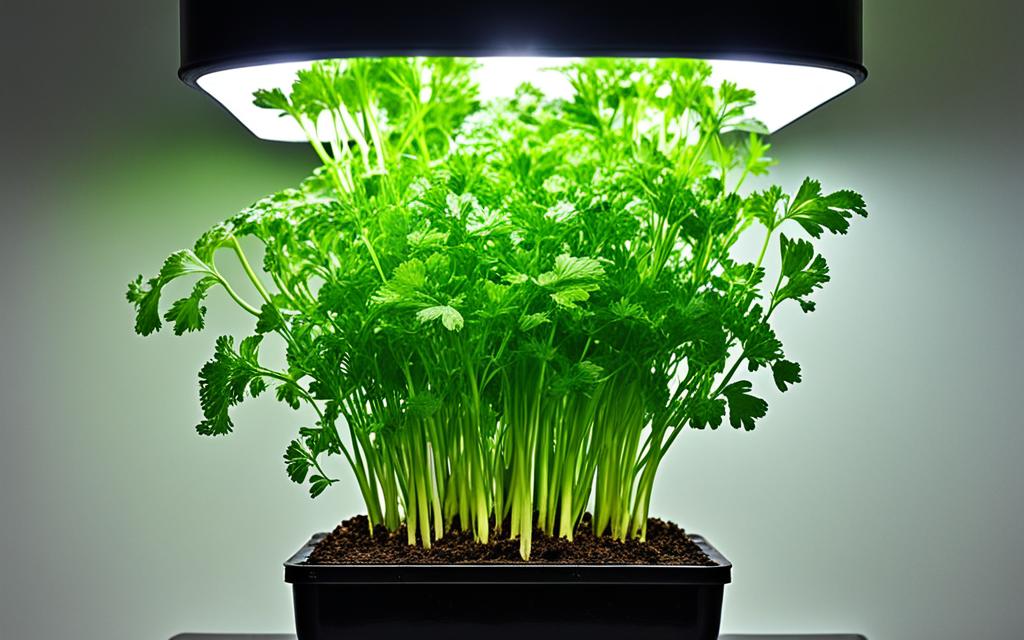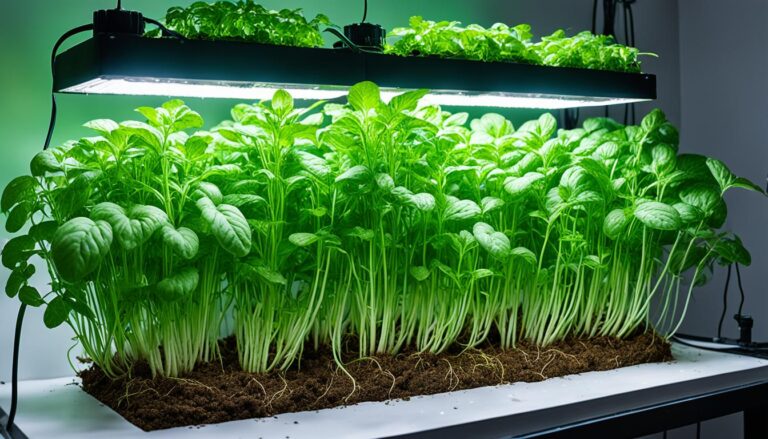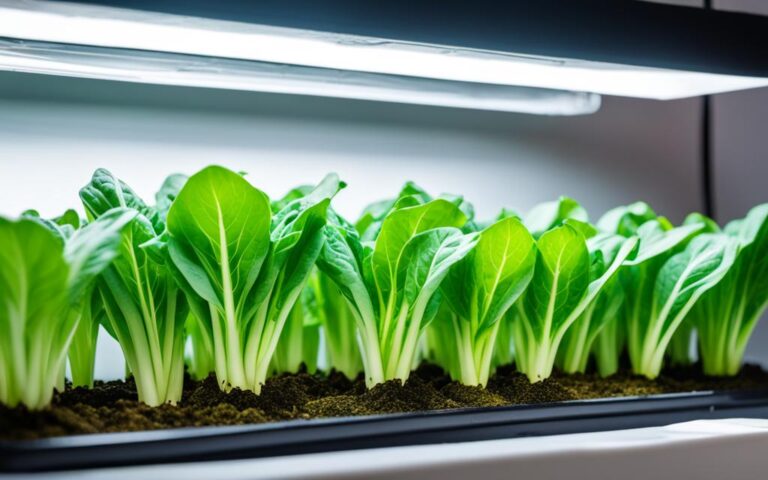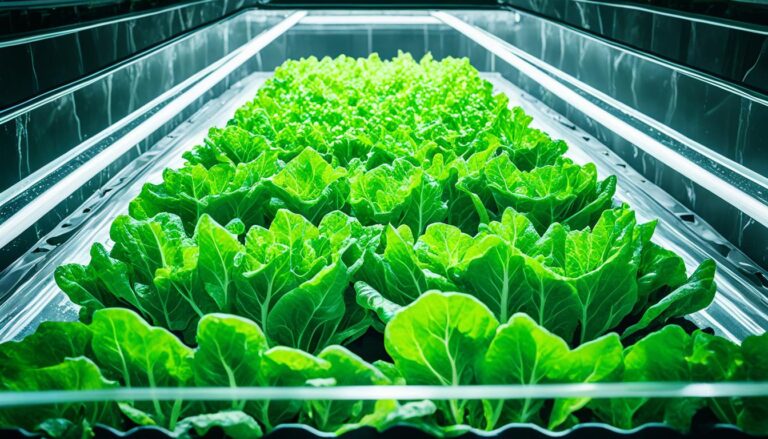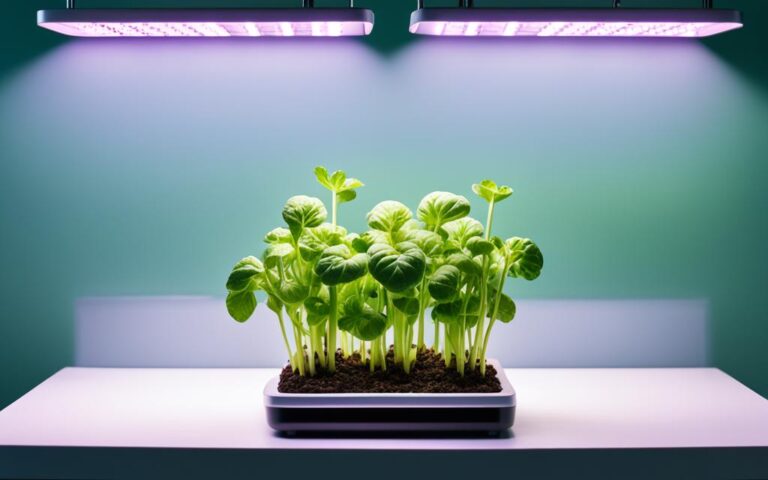Grow Hydroponic Parsley: Fresh & Flavorful Tips
Did you know hydroponic parsley can grow up to 30% more leaves than the traditional kind? This method lets you have a steady supply of this versatile herb all year, even in small indoor spaces. It’s perfect for both seasoned urban farmers and beginners. Growing hydroponic parsley is a great way to add fresh, tasty greens to your meals.
Key Takeaways
- Hydroponic parsley can yield up to 30% more leaves than soil-grown parsley
- Growing parsley hydroponically allows for year-round, indoor cultivation
- Hydroponic systems provide optimal growing conditions for parsley
- Selecting the right parsley variety and managing nutrients are key to success
- Hydroponic parsley can be a sustainable and space-efficient addition to urban gardens
Table of Contents
Introduction to Hydroponic Parsley
Parsley is a versatile herb with a long history. It’s used in both cooking and medicine. Growing hydroponic parsley is becoming popular. This method lets gardeners and farmers have parsley all year.
Benefits of Growing Parsley Hydroponically
Hydroponic parsley has many benefits. It gives higher yields and better nutrients. You can grow it all year, no matter the weather. It also uses less land and water, making it good for the planet.
Types of Parsley: Curly vs. Flat-leaf
There are two main types of parsley: curly parsley and flat-leaf (Italian) parsley. Both work well in hydroponics. They differ in how they grow and taste:
- Curly Parsley has curled leaves and tastes milder and sweeter. It’s great for garnishes, soups, stews, and salads.
- Flat-leaf Parsley has broad leaves and a stronger, peppery taste. It’s used in Mediterranean and Middle Eastern dishes, sauces, pesto, and marinades.
Hydroponic parsley is rewarding and productive for any garden, indoor or outdoor.
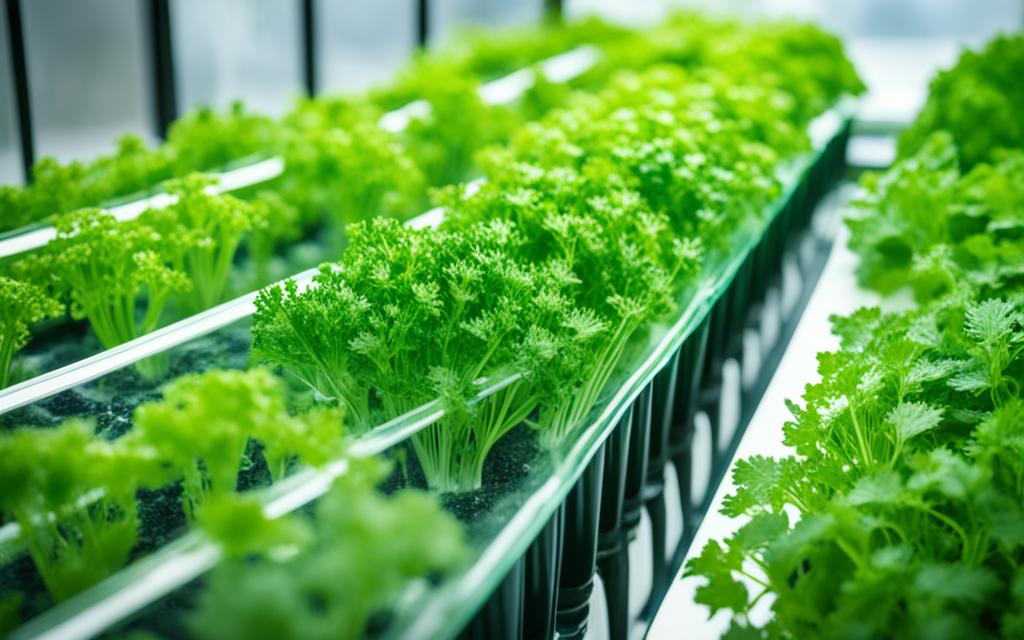
Selecting and Preparing Plants
When growing hydroponic parsley, you can start from seeds or use parsley transplants from a nursery. Each method has its own benefits. The choice depends on what you prefer and your growing conditions.
Best Hydroponic Parsley Varieties
Some top hydroponic parsley varieties include:
- Italian Flat-Leaf Parsley: A classic type with a strong flavor and great for cooking.
- French Curly Parsley: It has a delicate look and tastes slightly sweeter.
- Triple Curled Parsley: This variety produces leaves that are tightly curled and bright green.
Starting from Seeds vs. Transplants
Starting with seeds lets you control the growth and can save money. But, it takes longer to see results. Parsley transplants come with roots already developed. They can start your harvest sooner but are pricier and may face transplant shock.
| Criteria | Starting from Seeds | Using Transplants |
|---|---|---|
| Cost | Lower | Higher |
| Time to Harvest | Longer | Shorter |
| Control over Growing Process | More | Less |
| Transplant Shock Risk | Lower | Higher |
Choosing between starting parsley from seeds or using parsley transplants depends on your goals, timeline, and resources. Think about the good and bad of each method to pick the best for your hydroponic parsley.
Setting Up Your Hydroponic System
Choosing the right hydroponic system is key to growing parsley well. Parsley does well in many hydroponic setups, each with its own benefits. Let’s look at some popular options to help you pick the best one for you.
Choosing the Right Hydroponic System
The nutrient film technique (NFT) is a top choice for parsley. It uses a shallow stream of nutrient-rich water over the roots. This keeps the plants well-nourished and oxygenated. It’s simple, space-efficient, and perfect for indoor or small-scale parsley growing.
The ebb and flow system is also popular. Plants sit in a tray that gets flooded with nutrients and then drains. This system is flexible and works well for bigger parsley gardens.
If you prefer a low-maintenance option, consider the deep water culture (DWC) system. Here, roots are in a nutrient-rich reservoir with an air pump for oxygen. It’s easy to use and reliable for growing hydroponic parsley.
- Nutrient film technique (NFT)
- Ebb and flow (flood and drain)
- Deep water culture (DWC)
Think about space, maintenance ease, and automation level when picking a hydroponic system for parsley. The right system ensures your parsley grows well and gives you plenty of fresh, tasty leaves.
hydroponic Parsley Nutrient Requirements
Growing parsley hydroponically means giving it the right nutrients for the best growth and taste. Parsley is a leafy green that doesn’t need as much as plants that produce flowers or fruits.
A balanced hydroponic fertilizer for parsley, like Dyna-Gro Foliage Pro, gives the right hydroponic parsley nutrients for healthy growth. This fertilizer is high in nitrogen. Nitrogen makes the leaves green and lush, which is what we mainly harvest from parsley.
| Nutrient | Ideal Range |
|---|---|
| Nitrogen (N) | 150-200 ppm |
| Phosphorus (P) | 30-50 ppm |
| Potassium (K) | 150-200 ppm |
| Calcium (Ca) | 80-120 ppm |
| Magnesium (Mg) | 30-50 ppm |
Keeping the right balance of hydroponic parsley nutrients is key for tasty, bright parsley leaves. Checking and adjusting the parsley nutrient solution often helps your hydroponic parsley do well.
“The secret to growing exceptional hydroponic parsley lies in providing the right balance of essential nutrients.”
Light and Temperature Needs
Getting the right balance of light and temperature is key for growing healthy hydroponic parsley. Parsley does best in a temperature of 60-75°F and needs 12-14 hours of light daily. By meeting the parsley light requirements and parsley temperature range, your hydroponic parsley plants will grow strong and taste great.
Optimal Light Duration and Intensity
For hydroponic parsley lighting, think about using T5 fluorescent or LED grow lights. These lights give the right amount of light and last long, just like natural sunlight. Try to give your parsley 12-14 hours of good light every day for the best growth.
- T5 fluorescent lights are compact, save energy, and are great for growing parsley indoors.
- LED grow lights let you control the light’s strength and color, helping you adjust the environment perfectly.
- Make sure the light is close to the plants, 6-12 inches above, to meet the parsley light requirements.
“Proper lighting is key for growing healthy, tasty parsley in a hydroponic setup. Try different light sources and times to find what works best for you.”
Keep the right parsley temperature range and hydroponic parsley lighting for your plants. This will make a great place for your parsley to grow, giving you lots of fresh, tasty leaves.
Spacing and Planting Density
When growing hydroponic parsley, it’s key to get the spacing and density right for the best growth and yields. Keep the plants about 7-8 inches apart. This lets them grow well and get enough air, which is vital for healthy parsley.
Here’s why the right spacing and density matter:
- Promotes robust root growth and establishment
- Enhances air flow around the plants, reducing the risk of fungal diseases
- Allows for efficient nutrient and water uptake by the plants
- Optimizes light penetration, ensuring even distribution and maximizing photosynthesis
- Prevents overcrowding, which can lead to stunted growth and reduced yields
To get the best hydroponic parsley spacing and parsley planting density, follow these tips:
- Space plants 7-8 inches apart within the rows
- Maintain a row spacing of 8-10 inches between each row
- Adjust spacing based on the specific hydroponic system and grow tray dimensions
- Monitor plant growth and adjust spacing as needed to maintain optimal conditions
By using these guidelines for hydroponic parsley spacing and parsley planting density, you’ll help your hydroponic parsley grow strong and produce well.
pH and EC Ranges
Keeping the right pH and electrical conductivity (EC) levels is key for your hydroponic parsley to do well. The best pH range for hydroponic parsley is between 6.0 and 6.5. This ensures the plants absorb nutrients well and stay healthy.
Importance of Monitoring pH and EC
It’s vital to keep an eye on and adjust the pH and EC levels in your hydroponic setup. The pH affects how well parsley gets nutrients. The EC shows how much salt and nutrients are in the water.
When pH and EC levels are off, it can cause nutrient problems. This can slow down or stop your hydroponic parsley from growing right. Testing and adjusting these levels often is key to keeping your parsley healthy.
| Parameter | Optimal Range |
|---|---|
| pH | 6.0 – 6.5 |
| Electrical Conductivity (EC) | 0.8 – 1.8 mS/cm |
By watching the hydroponic parsley pH and hydroponic parsley EC, you help your plants get the right electrical conductivity for parsley. This way, they can grow well and give you fresh, tasty leaves.
“Precise pH and EC control are the keys to unlocking the full potential of your hydroponic parsley crop.”
Pruning and Harvesting Techniques
Proper pruning and harvesting techniques are key for getting the most out of your hydroponic parsley. Knowing when and how to prune and harvest keeps your plants healthy and productive. This way, you get a steady supply of fresh, tasty parsley leaves.
When and How to Prune Parsley
Regular pruning of hydroponic parsley makes the plants bushy and boosts leaf production. Prune your plants every 2-3 weeks, cutting the leaves and stems right at the base. This makes the plant focus on making more leaves instead of flowering or seeding.
Harvesting Tips for Optimal Yield
- Harvest parsley leaves often, but don’t take more than one-third of the plant at once.
- Use sharp scissors or pruners to cut the leaves, leaving at least 2 inches of stem for growth.
- Harvest in the morning for the best flavor, when leaves are crisp and oils are concentrated.
- Proper harvesting of hydroponic parsley helps the plant last longer and boosts the parsley yield.
“Consistent pruning and careful harvesting are the keys to growing a thriving, long-lasting hydroponic parsley crop.”
By using these pruning and harvesting tips, you can have a steady supply of fresh, tasty hydroponic parsley for cooking.
Common Pests and Diseases
Hydroponic parsley is less likely to get pests and diseases than soil plants. But, it’s still important to watch out for problems. Keeping an eye on your plants and acting fast can help keep them healthy.
Identifying and Treating Pest Infestations
Some pests can bother hydroponic parsley, such as:
- Aphids – These tiny bugs drink plant sap and can slow down growth. Use insecticidal soap or neem oil to control them.
- Spider mites – These tiny arachnids eat the underside of leaves, making them look bad and leaving webs. Raise the humidity and use miticides to fight them.
- Thrips – These thin bugs eat leaves, making them look silvery or speckled. Lacewings or predatory mites can eat these pests.
Spotting and treating these hydroponic parsley pests quickly is key to keeping your plants healthy.
Combating Hydroponic Parsley Diseases
Hydroponic parsley can also get diseases like:
- Powdery mildew – This looks like white powder on leaves and stems. Better air flow and a baking soda solution can fight it.
- Botrytis – Also called gray mold, it makes leaves and stems rot. Keep humidity right and don’t crowd the plants to stop it.
- Root rot – This comes from fungi and can make plants wilt, turn yellow, and die. Good drainage and checking nutrients can stop it.
By watching closely and using parsley pest control methods, you can keep pests and diseases away. This way, your hydroponic parsley will grow well and give you lots of harvest.
Troubleshooting Nutrient Deficiencies
Keeping the right amount of nutrients is key for healthy, green hydroponic parsley. But sometimes, even with great care, plants can face nutrient imbalances. This can cause problems like leaves turning color, growth slowing, or less produce. Knowing the signs of hydroponic parsley nutrient deficiencies and acting fast can help fix these issues.
Identifying Nutrient Deficiencies
Start by looking closely at your plants for signs of parsley nutrient issues. Watch for these common signs:
- Yellowing or discolored leaves
- Stunted or slowed growth
- Weak, brittle stems
- Wilting or drooping leaves
- Leaf curling or cupping
Spotting these symptoms helps you figure out which nutrient is missing. Then, you can fix it.
Addressing Nutrient Imbalances
After finding the nutrient problem, tweak your hydroponic system’s nutrient mix. You might add more of the missing nutrient, adjust the pH, or clean the system to remove bad salts or minerals.
| Nutrient Deficiency | Symptoms | Corrective Action |
|---|---|---|
| Nitrogen (N) | Yellowing of older leaves, stunted growth | Increase nitrogen in the nutrient solution |
| Phosphorus (P) | Purplish or reddish leaves, poor root development | Increase phosphorus in the nutrient solution |
| Potassium (K) | Leaf edges turning brown or scorched, weak stems | Increase potassium in the nutrient solution |
Keep an eye on your plants and adjust the nutrients as needed. This way, you can fix hydroponic parsley nutrient deficiencies and help your parsley grow well.
Maximizing Yields and Flavor
Getting the most out of your hydroponic parsley is crucial. Focus on lighting, temperature, nutrients, and pruning to boost yield and flavor. This way, you can enjoy a bountiful harvest of fresh parsley at home.
Tips for Achieving Optimal Growth
- Give your parsley plants bright, direct light for 12-16 hours a day. This helps them grow strong.
- Keep the temperature steady between 65°F and 75°F. Avoid big changes in temperature.
- Make sure your hydroponic system has the right mix of nutrients for parsley. Check and adjust the pH and EC levels often.
- Prune your plants to keep them bushy and healthy. Cut off older leaves and flower stalks as they grow.
By using these tips for hydroponic parsley yield and parsley flavor, you’ll get a great crop of parsley. With a bit of care, your hydroponic parsley plants can reach their full potential.
| Factors | Optimal Ranges |
|---|---|
| Light Duration | 12-16 hours per day |
| Temperature | 65°F to 75°F |
| pH | 6.0 to 7.0 |
| EC (Electrical Conductivity) | 1.2 to 2.4 mS/cm |
Companion Planting with Parsley
Parsley is a versatile herb that does well in hydroponics. It can grow well with other plants. Planting parsley with others brings many benefits, like better flavor, pest control, and nutrient uptake.
Parsley and basil are great together. Basil’s strong smell keeps pests away from parsley. They also make dishes taste better together.
Tomatoes and parsley are another good pair. Parsley’s fresh taste goes well with tomatoes. Tomatoes help parsley grow by giving it nutrients.
- Carrots and parsley work well together. Parsley keeps carrot flies away.
- Asparagus and parsley are a natural match. Parsley’s roots help asparagus grow better.
- Lettuces and parsley also go well together. Parsley keeps pests away from these greens.
| Companion Plant | Benefits |
|---|---|
| Basil | Enhances flavor, deters pests |
| Tomatoes | Balances sweetness, improves growth |
| Carrots | Repels carrot flies |
| Asparagus | Improves soil aeration and nutrient uptake |
| Leafy Greens | Deters aphids and other pests |
Pairing parsley with the right plants makes your hydroponic garden better. It uses the herb’s many benefits.
“Companion planting with parsley can be a game-changer for your hydroponic garden, providing a natural way to enhance flavor, control pests, and promote healthier plant growth.”
Preserving and Storing Parsley
Keeping your hydroponic parsley fresh and flavorful is key to enjoying it all year. You can use drying and freezing to keep it fresh. Each method has its own benefits.
Drying Parsley
Drying parsley leaves is a great way to keep them for later. Gather the stems into small bunches and hang them upside down in a cool, dry spot. Or, use a dehydrator on low to dry them out fast, keeping their flavor and smell.
Freezing Parsley
To keep parsley for even longer, try freezing your hydroponic parsley. First, blanch the leaves in boiling water for 30 seconds to a minute. Then, cool them in an ice bath quickly. Dry the leaves well and put them in airtight containers or freezer bags, squeezing out the air. This way, you keep the parsley’s texture and taste when you need it.
Choosing how to preserve your parsley is important. Proper storage is key to keeping your preserved hydroponic parsley fresh and tasty. Keep the dried or frozen parsley in a cool, dark spot. Use it within 6-12 months for the best quality and flavor.
“Preserving the harvest is an important step in maximizing the benefits of your homegrown hydroponic parsley.”
Culinary Uses and Recipes
Hydroponic parsley is a versatile ingredient that can elevate many dishes. It’s great for vibrant garnishes, flavorful sauces, hearty soups, and refreshing salads. Explore these recipes to see how homegrown parsley recipes can enhance your meals.
Parsley-Infused Dishes
Parsley’s bright, grassy notes work well with both savory and sweet dishes. Try adding cooking with hydroponic parsley to these recipes:
- Chimichurri sauce – a vibrant condiment that pairs perfectly with grilled meats
- Parsley pesto – a versatile spread that can be tossed with pasta, spread on crostini, or used as a dip
- Parsley-garlic roasted potatoes – a simple yet delicious side dish
- Parsley and lemon-infused vinaigrette – a light, tangy dressing for salads or roasted vegetables
Parsley in Soups and Stews
Parsley in cuisine adds fresh flavor to hearty soups and stews. Add chopped parsley to these dishes:
- Minestrone soup – for a bright, herbal accent
- Beef and barley stew – to balance the richness of the dish
- Chicken noodle soup – for a classic, comforting touch
Hydroponic parsley is versatile and can enhance any dish. Its flavor will surely delight your taste buds.
“Parsley is the foundation of so many wonderful dishes, adding a fresh, vibrant flavor that can really make a meal shine.”
Conclusion
Growing hydroponic parsley at home is rewarding and practical. It gives you fresh, flavorful herbs all year. This guide has shown you how to set up and keep a thriving hydroponic parsley garden.
You now know how to pick the best hydroponic system and parsley types. You also understand how to create the best growing conditions and maintain your plants. This guide has given you the knowledge and skills to grow hydroponic parsley with confidence.
Whether you’re experienced or new to gardening, this information will guide you. It will help you grow hydroponic parsley and enjoy its many benefits in cooking and health.
Starting your hydroponic parsley garden means keeping an eye on your plants. Adjust the nutrients and watch for pests or diseases. This way, you’ll get the most from your plants and enjoy the fresh taste of your homegrown parsley. Happy gardening!
